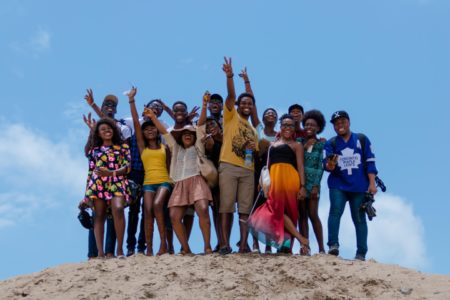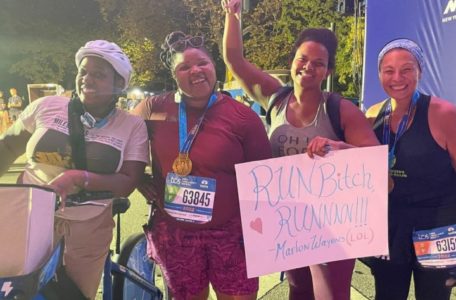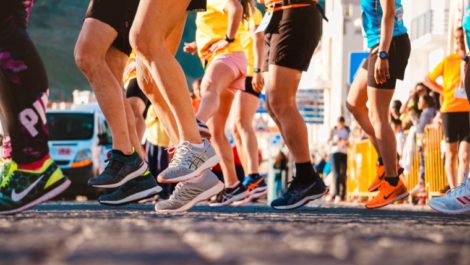There are moments in life which change us forever. For me, the New York City marathon was one of them.
When I set out early on the train to Brooklyn, the weather was warm for November. I loved it, but for the runners expecting fall chill, the conditions weren’t ideal. The race started on the Verrazzano Bridge in Staten Island, but since no spectators were allowed there, Bay Ridge was the closest I could get.
I wanted to see the runners when they were at their freshest; before the sweat and strain were plain to see on their faces.
After fueling with a bagel and coffee, I stood behind the barricades with my homemade sign. One side had a quote from Marlon Wayans in Scary Movie: “Run, b*tch! Runnnn!” The other gushed, “I’m So Proud Of You!”
And honestly? I was proud of every participant. 26.2 miles is not a joke.
The slogan for the marathon was, “It Will Move You.” But I had no idea just how true that was until later.
Why Was It So Special?

2022 marked the first year the marathon was taking place at full capacity in the COVID era.
Over 50,000 people participated. There were the elites, the wheelchair racers and the general runners.
Not everybody ran. Some power-walked. Some used canes or walkers. And I’m sure somebody crawled when their legs gave out.
It didn’t matter. The objective was to get over that finish line.
I Went To Support My Friends

I was never really interested in watching marathons before. But this year was different.
The fact that it was at full capacity meant that life was returning to normal. Also, four of my friends were participating.
I know David and Kai through tower climbing. A shared interest in fitness introduced me to Latoya and Cemohn. They are incredibly driven people.
The most meaningful way to show my love was to be out there on the course.
There Were All Kinds Of Athletes

I knew the Africans were going to impress, and they surely did.
Kenya’s Sharon Lokedi and Evans Chebet won. What’s more, several of the runners after them were also African.
Cemohn blew me a kiss and was gone in a flash. I tried to run after her on the sidewalk so I could snap a picture. That was a fool’s errand.
As participants rushed past in droves, I rooted and waved my sign over my head. It was amazing I had a voice left!
Some people were in costume. Then there were the Achilles athletes who were mostly blind and accompanied by guides.
A woman in her 80s pushed herself along the course with two canes. What a warrior she was.
Even a duck waddled down the street, following the snacks his handler put out.
How Did The Community Support The Runners?

After David, Cemohn and Kai finished, I kept an eye out for Latoya.
She’s a “Back of the Pack” athlete who walked most of the marathon. I promised that I wouldn’t leave until she finished, and I kept my word.
As night fell, the crowds thinned and the barricades were removed. The street by Columbus Circle partially re-opened for bikes and cars. It was the city’s way of saying, “okay folks, let’s wrap this up.”
But a handful of spectators stayed on.
I met Courtney, who was also waiting for Latoya. This remarkable woman made several trips between boroughs to provide snacks and water for the Back of the Pack gang.
The Finish Was The Most Moving Part

Latoya arrived at Columbus Circle with a woman she befriended on the course named Darlene.
While the first was a marathon veteran, the second was doing it for the first time and with very little training.
The four of us entered Central Park, with Courtney on her bike.
I was about to step to the side so Latoya and Darlene could have their moment in the sun. This was their achievement, not mine.
But Latoya wouldn’t hear of it. She insisted the quartet cross the finish line hand in hand.
There were hugs, tears and plenty of photos. It was an electric experience, and the good folks of Project Finish helped make the last participants feel recognized.
Running Provides Healing

Latoya documented her marathon journey on social media. She’s been frank about how chronic health conditions impact her day to day.
“A lot of the endurance game is mental,” she said. “I show up, not just for me. But to show other people you are capable, you are deserving, you are an athlete. Trust yourself to be able to carry out the task. It may not look like everybody else’s, but it’s yours. Own it.”
Darlene’s sentiments were vaguely similar.
Running was her therapy after a breakup in 2019. As a single mother and the caregiver of two parents with dementia, she knows what it’s like to spread herself thin.
“I did genetic testing and I’m at high risk for colon and breast cancer,” she said. She had a double mastectomy and several other surgeries before the doctor cleared her to run again.
“I’m the one taking care of everyone, so it didn’t leave a lot of time to train for a marathon,” Darlene admitted. “Running helps me recharge my battery. Everyone relies on me, so if I don’t have my mental health, everything falls apart.”
Why Didn't I Sign Up For The Marathon?

I’ve done a handful of 5Ks, and two half- marathons. But I’ve yet to tackle a full marathon.
After witnessing what I did on Sunday, I’d like to work towards doing a marathon.
I’ve got a short run lined up for December, and will do a few more before tackling longer distances.
When I finally manage “the real deal,” I’ll write about it, provided I don’t croak.





